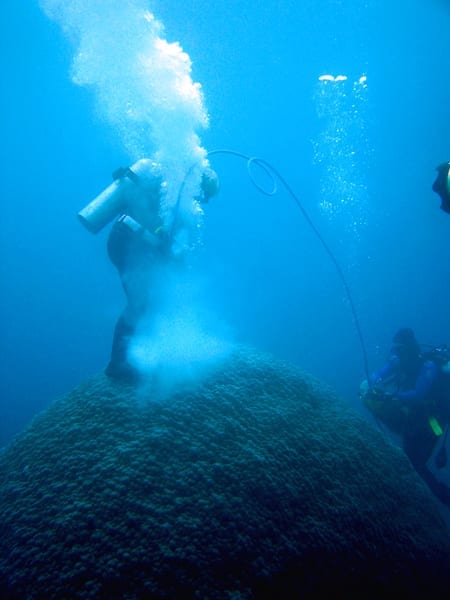By Daniel de la Calle
We are half way into the month of February and very much in need of some news about Ocean Acidification, coral reefs and the environment:
»Australian study finds that coral reefs in colder waters have benefited from warmer conditions over the past 110 years. The work was carried out in West Australian waters by taking cores from massive porites corals and measuring while counting back. Some cores dated back to the 18th century, but the study was done from 1900 to 2010. Scientific American has a text on this study as well.
Image from the Australian Research Council, Coral Reef Studies
»To the surprise of some of us, warming waters and changes in ocean chemistry are accepted and in some cases awaited by certain coastal communities. This piece about the increased presence of marlin in (warmer now) Tasmanian waters constitutes a good example.
“The ocean off Tasmania’s East Coast is changing so fast you can see it change”, CSIRO climate scientist Alistair Hobday said. “New species are showing up all the time”…
»The Bermuda Institute of Ocean Sciences is going to begin extensive new mapping of its coral reefs using high definition satellite images “to understand what is happening to reefs, and how they are responding to the impact of nature and humans,” says Dr Eric Hochberg, principal investigator for the Marine Environmental Program at BIOS. “We want to know how the coral reef system works. We also want to understand the impact of ocean acidification and global warming on the coral reef.”
»The Manila Declaration was adopted on January 27th by the 65 countries attending the UN-backed conference mentioned on our previous post. It is an agreement “to step up efforts to protect the world’s oceans from land-based activities, stressing the marine environment’s central role in the transition to a low-carbon, resource-efficient green economy”. It contains a total of 16 provisions that focus on actions to be taken between this year and 2016 at international, regional and local levels.
»Al Gore writes about Antarctica and Ocean Acidification for the Huffington Post.
»An interesting article from Bloomberg.com on energy consumption and production in the USA and self-sufficiency not too long from now.
»The news that sea cucumbers could “save” the Great Barrier Reef swept across the internet a week or two ago. Scientists from the University of Sydney at One Tree Island believe that when cucumbers ingest sand “the natural digestive processes in the sea cucumber’s gut increases the pH levels of the water on the reef where they defecate,” said Tree Island director professor Maria Byrne.
“The research at One Tree Island showed that in a healthy reef, dissolution of calcium carbonate sediment by sea cucumbers and other bioeroders appears to be an important component of the natural calcium carbonate turnover.”
Some 30 species are commercially harvested by the fishery industry along the Great Barrier Reef and throughout the tropics, as has been done for centuries (see below HS Melville’s 1845 etching depicting the process of trepang smoking and drying). “We urgently need to understand the impact of removing sea cucumbers and other invertebrates on reef health and resilience at a time when reefs face an uncertain future,” Prof Byrne said.
»A piece in Business Insider informs about the discovery by a group of scientists of an improved method to capture CO2 from the atmosphere. The article states that the alleged findings, published in the Journal of the American Chemical Society, “reveal a new solid material based on polyethyleniminine that can be used as an absorbent to scrub CO2 from the air. […] This material can be used at both industrial sources, such as power plants and factories, as well as small distributed sources like car exhausts. It can even be used to capture CO2 directly from the open atmosphere.” They also claim it is regenerable, inexpensive, easy to prepare and less energy intensive than other methods. The adjective “incredible” has two meanings.


